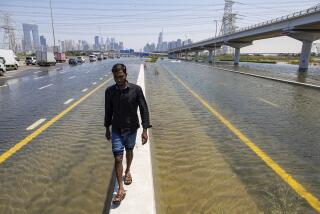In Oil-Rich State of Kuwait, Only the Imported Stuff Will Do--Even if It’s Sand
KUWAIT — Even as summer storms swirl tons of sand around in this desert Persian Gulf emirate, ships are arriving with more of the stuff.
A lesser-known irony of Kuwait, much of which is a sea of sand, is that it has to import 35,000 tons of sand each year.
“The local sand is too salty for building or agriculture,” said James Tuttle, a British engineer who has spent 10 years in the oil-rich emirate at the head of the gulf.
“Salt affects mortar very badly. It’s fine for a couple of weeks and then it starts cracking up,” said Tuttle, adding that it was also no good to grow crops. “It is far too coarse and salty to grow anything.”
Kuwait, transformed by oil from a fishing and pearl-diving center into a modern cosmopolitan city-state, has gone as far afield as Norway and Pakistan to buy sand to meet its needs.
Neighboring Saudi Arabia and Iraq also figure among the emirate’s suppliers, as does Jordan.
Forestation Drive
Despite the downturn in oil prices, much building continues, and horticultural needs are expected to boom after a national forestation drive to roll back the desert and turn the emirate green was declared this year.
The Kuwait Institute for Scientific Research in a recent paper also identified a need for good quality sand in other industries.
It is used as a silica source for fiberglass manufacture and as a filter in making reinforced plastic pipes used by the oil industry.
The harsh desert summers drive many Kuwaitis abroad on holidays. Most harbor greater dread of the sandstorms than the scorching heat, in which temperatures hit 122 degrees Fahrenheit and more.
During a storm high winds whip sand into the air, the sky turns an eerie twilight color and the sun becomes a grayish ball. “Dust carried by the wind gets everywhere, even in a locked cupboard in a flat where the doors and windows are shut,” warns a popular guide for newly arrived expatriates.
Health officials warn smokers to cut down and advise people to use scarves and masks to avoid breathing in the sand whistling on the wind.
At times, visibility may fall to zero, cautions an official weather guide compiled by the Civil Aviation Department’s weather division.
Severe Hazards
Gale-force sandstorms, fairly frequent at this time of the year, force airport closures, halt loading and unloading of oil tankers and cargo ships and create a headache for drivers who, despite the use of headlights and warning hazard flickers, are reduced to blindly nosing their way around.
Three years ago a motorist died of thirst after straying from a highway during a sandstorm into the desert, where he got stranded in soft sand.
Between May and August, dust contaminates more than one-quarter of the atmosphere, official figures show. During June and July the figure rises to more than one-third.
About the only good thing about a sandstorm is that it lowers the temperature.
Whenever it gets too hot, the weatherman says, with luck, a sandstorm will block out the sun’s rays and bring a bit of relief.
More to Read
Sign up for Essential California
The most important California stories and recommendations in your inbox every morning.
You may occasionally receive promotional content from the Los Angeles Times.










